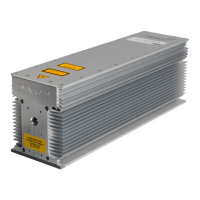technical reference
36
SYNRAD OEM v30 Operator’s Manual Version 2
Technical overview
The Technical overview section includes subsections:
■ OEM v30 laser
■ Optical setup
OEM v30 laser
Laser tube
Firestar
®
OEM v30 lasers were developed using new technology patented by SYNRAD, Inc. This patented
“v” technology, based on a combination of free-space and waveguide resonator designs, enables SYNRAD
to economically produce a symmetrical laser beam from a small but powerful laser capable of operating for
many years with virtually no maintenance. Firestar’s unique extruded aluminum envelope oers excellent
heat transfer, long gas life, and low operating costs in contrast to other laser tube technologies. In addi-
tion to being the vessel that maintains the lasing environment, the aluminum tube is also the structural
platform that integrates the laser’s optical, electrical, and cooling components.
Optical resonator
The optical resonator, in conjunction with the electrodes and the gas mixture, generates the laser beam.
Firestar v30 optical resonators are comprised of four optical elements: a rear mirror, two turning mirrors,
and an output window. These optical elements are fastened to the tube’s exterior and are exposed to its
interior through holes in the end caps. O-rings sandwiched between optical elements and each end cap
form a gas seal and provide a exible cushion that allows the slight movement necessary for alignment. All
optical elements are aligned and locked into place by factory technicians before the laser is shipped.
The output beam, roughly circular as it exits the resonator, transitions to a Gaussian-like mode in mid
and far elds—three meters (9.8 ft) and beyond. The internal structure and optics of the resonator
combine to produce a Gaussian-like mode quality (M
2
factor) of < 1.2. As shown in the following gure,
beam waist diameter is 2.5 mm ±0.5 mm at the output aperture and full angle divergence due to dif-
fraction is less than 7 milliradians (a 7 mrad full angle divergence means that beam diameter increases 7
mm over every one meter distance traveled).
Caution
possible
equipment
damage
Because of their smaller beam diameter, Firestar v30 lasers have
signicantly higher power densities than other SYNRAD lasers. This
means that any contaminants on the laser’s output coupler (or on
any beam delivery optic) can absorb enough energy to damage one or
more optics in the beam path. Periodically inspect the laser’s output
coupler and all other beam delivery optics for signs of contaminants,
and then carefully clean as required. In dirty environments, purge
laser optics using ltered air or nitrogen to prevent vapor and debris
from accumulating on optical surfaces.

